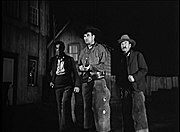
Lordsburg is a city in and the county seat of Hidalgo County, New Mexico, United States. Hidalgo County includes the southern "bootheel" of New Mexico, along the Arizona border. The population was 2,797 at the 2010 census, down from 3,379 in 2000.

John Martin Feeney, known professionally as John Ford, was an American film director and producer. He is regarded as one of the most important and influential filmmakers during the Golden Age of Hollywood, and was one of the first American directors to be recognized as an auteur. In a career of more than 50 years, he directed over 140 films between 1917 and 1965, and received six Academy Awards including a record four wins for Best Director for The Informer (1935), The Grapes of Wrath (1940), How Green Was My Valley (1941), and The Quiet Man (1952).

Monument Valley is a region of the Colorado Plateau characterized by a cluster of sandstone buttes, the largest reaching 1,000 ft (300 m) above the valley floor. The most famous butte formations are located in northeastern Arizona along the Utah–Arizona state line. The valley is considered sacred by the Navajo Nation, the Native American people within whose reservation it lies.

Rio Grande is a 1950 American romantic Western film directed by John Ford and starring John Wayne and Maureen O'Hara. It is the third installment of Ford's "Cavalry Trilogy", following two RKO Pictures releases: Fort Apache (1948) and She Wore a Yellow Ribbon (1949). Wayne plays the lead in all three films, as Captain Kirby York in Fort Apache, then as Captain Nathan Brittles in She Wore a Yellow Ribbon, and finally as a promoted Lieutenant Colonel Kirby Yorke in Rio Grande. Rio Grande's supporting cast features Ben Johnson, Claude Jarman Jr., Harry Carey Jr., Chill Wills, J. Carrol Naish, Victor McLaglen, Grant Withers, the Western singing group the Sons of the Pioneers and Stan Jones.

The Big Trail is a 1930 American pre-Code Western early widescreen film shot on location across the American West starring 23-year-old John Wayne in his first leading role and directed by Raoul Walsh. It is the final completed film to feature Tyrone Power Sr. before his death in 1931, as well as his only sound role.
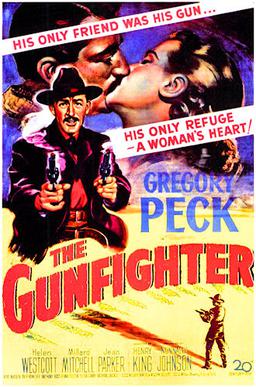
The Gunfighter is a 1950 American Western film directed by Henry King and starring Gregory Peck, Helen Westcott, Millard Mitchell and Karl Malden. It was written by screenwriters William Bowers and William Sellers, with an uncredited rewrite by writer and producer Nunnally Johnson, from a story by Bowers, Roger Corman, and screenwriter and director Andre de Toth. The film was the second of King's six collaborations with Peck.

Ernest James Haycox was an American writer of Western fiction.

She Wore a Yellow Ribbon is a 1949 American Technicolor Western film directed by John Ford and starring John Wayne. It is the second film in Ford's "Cavalry Trilogy", along with Fort Apache (1948) and Rio Grande (1950). With a budget of $1.6 million, the film was one of the most expensive Westerns made up to that time. It was a major hit for RKO. The film is named after "She Wore a Yellow Ribbon", a song popular with the US military.
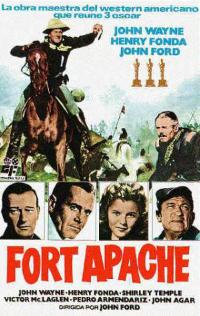
Fort Apache is a 1948 American Western film directed by John Ford and starring John Wayne and Henry Fonda. The film was the first of the director's "Cavalry Trilogy" and was followed by She Wore a Yellow Ribbon (1949) and Rio Grande (1950), both also starring Wayne. The screenplay was inspired by James Warner Bellah's short story "Massacre" (1947). The historical sources for "Massacre" have been attributed both to George Armstrong Custer and the Battle of Little Bighorn and to the Fetterman Fight.

Geronimo: An American Legend is a 1993 historical Western film starring Wes Studi, Jason Patric, Gene Hackman, Robert Duvall, and Matt Damon in an early role. The film, which was directed by Walter Hill, is based on a screenplay by John Milius. It is a fictionalized account of the Apache Wars and how First Lieutenant Charles B. Gatewood convinced Apache leader Geronimo to surrender in 1886.
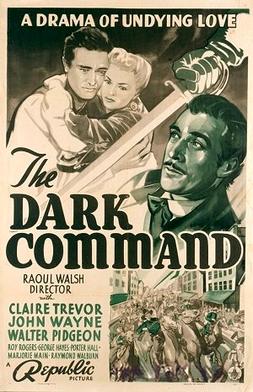
Dark Command is a 1940 Crime western film starring Claire Trevor, John Wayne and Walter Pidgeon loosely based on Quantrill's Raiders during the American Civil War. Directed by Raoul Walsh from the novel by W. R. Burnett, Dark Command is the only film in which western icons John Wayne and Roy Rogers appear together, and was the only film Wayne and Raoul Walsh made together since Walsh discovered Wayne working as a prop mover, renamed him, and gave him his first leading role in the epic widescreen Western The Big Trail a decade before.

Allegheny Uprising is a 1939 American Adventure Western film directed by William A. Seiter and starring Claire Trevor and John Wayne. Based on the 1937 novel The First Rebel by Neil H. Swanson, with a screenplay by the film's producer, P. J. Wolfson, the film is loosely based on the historical event known as the Black Boys Rebellion, which took place in 1765 after the conclusion of the French and Indian War. It was produced by RKO Pictures.
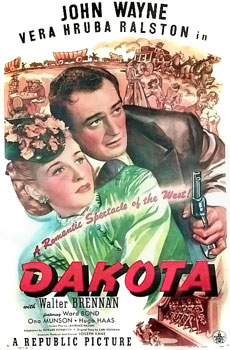
Dakota is a 1945 American Western film directed by Joseph Kane, and starring John Wayne. The supporting cast features Walter Brennan, Ward Bond, and Mike Mazurki.
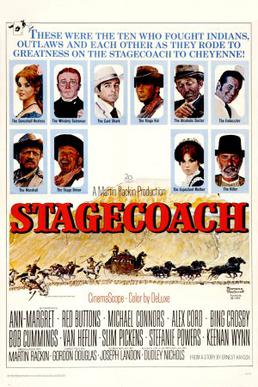
Stagecoach is a 1966 American Western film, directed by Gordon Douglas between July and September 1965, as a color remake of the Academy Award-winning John Ford 1939 classic black-and-white western Stagecoach. Unlike the original version which listed its ten leading players in order of importance, the major stars are billed in alphabetical order.

Stagecoach is a 1986 American Western television film directed by Ted Post and written by James Lee Barrett. It is a remake of the 1939 film of the same name, itself based on a short story by Ernest Haycox. It is the second remake of the film, after the 1966 feature film. Kris Kristofferson stars as the Ringo Kid. Willie Nelson portrays famous gunslinger and dentist Doc Holliday, Johnny Cash portrays Marshal Curly Wilcox and Waylon Jennings plays the gambler Hatfield. All four stars were associated as members of the country music supergroup The Highwaymen. The supporting cast features Elizabeth Ashley, Anthony Newley, Tony Franciosa, Mary Crosby, June Carter Cash and Jessi Colter. The film aired on CBS on May 18, 1986.
Winchell is a 1998 American biographical drama television film directed by Paul Mazursky and written by Scott Abbott, based on the 1976 book Winchell, His Life and Times by Herman Klurfeld. It stars Stanley Tucci as Walter Winchell, with Glenne Headly, Paul Giamatti, Xander Berkeley, Kevin Tighe, and Christopher Plummer in supporting roles.

Ned Scott was an American photographer who worked in the Hollywood film industry as a still photographer from 1935 to 1948. As a member of The Camera Club of New York from 1930 to 1934, he was heavily influenced by fellow members Paul Strand and Henwar Rodakiewicz.

Apache War Smoke is a 1952 American Western film directed by Harold F. Kress and starring Gilbert Roland, Glenda Farrell, and Robert Horton. The film is based on the 1939 short story "Stage Station" by Ernest Haycox. It was released by MGM on September 25, 1952. An outlaw murders several Apaches and flees to a stagecoach station with the tribe in hot pursuit.

Apache Trail is a 1942 American Western film directed by Richard Thorpe, written by Maurice Geraghty, and starring Lloyd Nolan, Donna Reed, William Lundigan, Ann Ayars, Connie Gilchrist, and Chill Wills. The picture was released on June 24, 1942, by Metro-Goldwyn-Mayer.
Apache Wells is the name of both fictional and real locations in southern Arizona.










